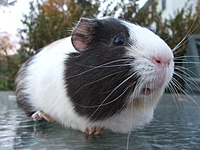
Photo from wikipedia
Absorption of dietary lipids in the small intestine is dependent on the emulsification by bile acids (BA) and the formation of chylomicrons. Cholestyramine is a common drug used in humans-and… Click to show full abstract
Absorption of dietary lipids in the small intestine is dependent on the emulsification by bile acids (BA) and the formation of chylomicrons. Cholestyramine is a common drug used in humans-and potentially dogs-to treat BA malabsorption associated with chronic diarrhea. It is known to bind BA to form insoluble complexes, preventing their reabsorption and possibly proper emulsification and absorption of dietary fats. The objective of this study was to evaluate the effects of cholestyramine on 1) macronutrient apparent total tract digestibility (ATTD), and 2) fecal characteristics and metabolites of healthy adult dogs. We hypothesized that cholestyramine would decrease ATTD of fat and organic matter (OM), increase fecal dry matter (DM) content, and increase fecal output. Twelve healthy beagles (3.2 ± 0.8 yr; 10.4 ± 0.9 kg) were used in a randomized crossover design. All procedures were approved by the University of Illinois Institutional Animal Care and Use Committee before the study. The study included a baseline period and two 14-d experimental periods separated by a 14-d washout. All dogs were fed the same experimental diet, formulated to meet all nutrient needs recommended by AAFCO, throughout the study. Dogs were randomized into 2 groups [diet only (control) or diet + 11.4 g/d cholestyramine (8 g/d active ingredient)] in Period 1 and received the other treatment in Period 2. During the washout, all dogs were fed the diet only. Dogs were fed once daily (0800 h) to maintain BW. Total fecal output was collected during the last 4 d of each period for ATTD analysis. On day 14 of each of period, fresh fecal and blood samples were collected for metabolite analysis. Dogs fed cholestyramine had lower (P < 0.001) ATTD of DM, OM, energy, crude protein, and fat and lower (P < 0.01) fecal scores (firmer stools) than controls. Dogs fed cholestyramine had greater (P < 0.01) as-is and dry fecal output than controls. Dogs fed cholestyramine had lower (P < 0.05) fecal ammonia and phenol concentrations, but greater (P < 0.05) fecal indole, acetate, butyrate, and total short-chain fatty acid concentrations than controls. Fecal DM% and pH were greater (P < 0.01) in dogs fed cholestyramine. Our results indicate that cholestyramine, when given with a meal, is safe and well tolerated but significantly decreases nutrient digestibility and alters fecal characteristics. Future studies are required to explore the effects of cholestyramine on dogs with gastrointestinal disease.
Journal Title: Journal of animal science
Year Published: 2019
Link to full text (if available)
Share on Social Media: Sign Up to like & get
recommendations!